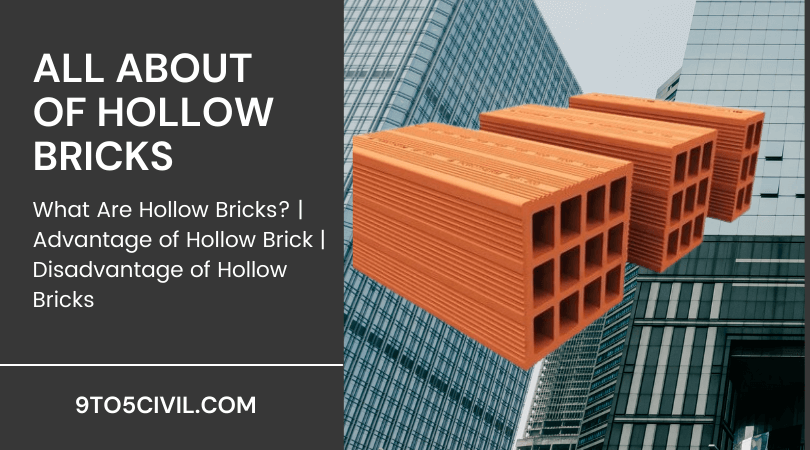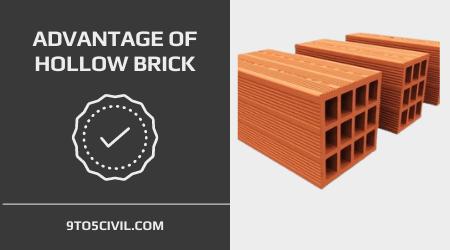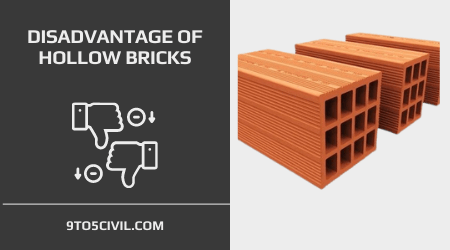
Hollow Bricks
Information about hollow bricks is presented in this article as follows.
Bricks are the essential element for the elevation of a building and the design of a room in a building. Brick helps in the elevation of the building as per the design. Brick masonry increases the dead load in the structure of the building.
Brick is traditionally used in the construction of any building. Research is currently underway in the construction industry to develop effective building materials with new technology.
Using the right type of brick for construction can be beneficial and economical for the building.
Hollow bricks are used for construction with advanced technology. Its use has become very popular due to its various features.
The use of hollow bricks can reduce the dead load of the building structure. Hollow bricks are therefore used as the most lightweight building material used for construction.
What Are Hollow Bricks?
According to the Green Building Council of India, hollow bricks are rated as building materials. According to this rating, hollow bricks are an environmentally friendly building material used for construction.
It is made by the proper mixing of various materials such as recycled waste and coal ash, rice dust, and fly ash.
The main function of hollow brick is to reduce the dead load in the structure of the building. Therefore hollow bricks are used as lightweight material to reduce the dead load in the construction of buildings. The holes present in the hollow brick help reduce the weight of the brick and make it lighter.
Hollow bricks are commonly referred to as porotherm bricks in construction. It is a brick made with advanced technology, which is being widely used in the construction industry due to its various advantages.
Hollow bricks have vertical holes made in them. Hollow bricks have better efficiency than conventional bricks.
Hollow bricks are environmentally friendly. These types of bricks absorb less water than conventional bricks. Since hollow bricks are lightweight, the speed of construction of the building can be increased.
These types of bricks are commonly used as partitions in buildings. But hollow bricks can also be used as load-bearing walls in a building.
It is used in construction as thermal insulation. Which helps maintain the temperature in extreme weather conditions.
The thermal insulation of hollow bricks is more than conventional bricks. The strength of hollow bricks can be increased by filling in the holes in the bricks.
Uniform quality and fast construction can be done by building with hollow bricks. So hollow brick is a building material for economical and cost-effective.
Advantages of Hollow Brick
The various advantages of hollow bricks are as follows.
- Hollow bricks can provide sound insulation properties in the building.
- The hollow bricks help maintain the temperature in the building.
- Hollow bricks are environmentally friendly building materials for building.
- Hollow bricks have better fire resistance than conventional bricks used in construction.
- The use of hollow brick in building construction proves to be economical in the total cost of the building.
- Lines for electrical and plumbing can be easily fixed in hollow brick construction. Because it is a brick hollow, it can be easily cut as required.
- Hollow bricks have good compressive strength properties. Therefore, it can be used in building as masonry work for load-bearing walls.
- Hollow bricks have thermal insulation properties, which help maintain the effect of cooling and heat in extreme outdoor weather conditions.
- Hollow brick gives a good architectural effect to the building.
Disadvantage of Hollow Bricks
Disadvantages of hollow bricks are as follows
- The use of hollow bricks up to the plinth in the area where the water table is high in the construction area of the building should be avoided. Because hollow brick has a low density, it cannot resist external forces.
- Hollow bricks have a lower load-bearing capacity than conventional bricks in construction.
- Hollow bricks cannot be used to construct heavy structures and foundations of buildings.
- Hollow bricks cannot be used as a component in a building in an earthquake zone area.
Also Read : What Is Lintel? | Size of Lintel Beam | Purpose of Lintel | Types of Lintel | Advantages of Lintel Beam
Sizes of Hollow Bricks
Different hollow bricks are used as required at different stages during construction. Used according to the functions of hollow brick. As examples, partition walls, compound walls, etc.
Thus, different sizes of hollow bricks are used as required.
Hollow bricks of different sizes can be used for the partition wall. The thickness of the partition wall may vary according to the need of the building.
Hollow bricks are available in different sizes in the market as follows,
- 400 mm x 200 mm x 100 mm
- 400 mm x 200 mm x 150 mm
- 400 mm x 200 mm x 200 mm
- 400 mm x 200 mm x 300 mm
How to Make Hollow Bricks?
Hollow bricks are made in molds of various sizes and designs. Hollow bricks are produced in different sizes as per requirement. Compositions like core and deep frogs of various hollow spaces can be made in hollow brick.
In the manufacturing process, cement, stone chips, sand, etc., as raw materials, are mixed properly in a mixer machine in a ratio of 1: 6. This mixture is filled into a mold. The pressure machine then compacts the mold to the appropriate pressure.
The brick form is formed in the pressed mold, which is removed from the mold and dried for 24 hours. The prepared Brick is then cured for 7 days.
The curing process is done for two weeks to give the hollow brick sufficient strength.
Hollow Bricks Properties
1. Fire Resistance
Hollow brick is used in construction as an excellent quality fire-resistant material.
Excellent fire-resistant materials can be made using fire clay for hollow brick.
2. Sound Resistance
Hollow bricks have better sound insulation than conventional bricks.
According to one test, the design and layout of holes in hollow bricks affect the sound insulation property. Cross web design inside hollow bricks is better than static web design for average sound insulation.
In some hollow brick designs, the sound resistance can be increased by inserting sound insulation material into the large holes in the brick.
3. Water Resistance
The water resistance of hollow bricks depends mainly on the quality of the material and the material used for their production.
The hollow brick can be strengthened by providing a drainage system to correct these defects.
In this way, water-resistance in hollow brick masonry can be increased, which reduces dampness through drainage in the wall.
4. Flexural Strength of Hollow Brick
Flexural strength in hollow masonry depends on the mortar mixture used for masonry. The flexural strength of hollow bricks can be increased by using reinforcement in the masonry work of hollow bricks in construction.
Hollow brick masonry exhibits less flexural tensile strength than solid brick masonry made with the same mortar.
5. Compressive Strength
The compressive strength of hollow brick is determined by testing based on the cross-sectional area of hollow brick. According to ASTM C652, the standard specification for hollow bricks uses compressive strength in the total area of the hollow brick.
The compressive strength of the net area of hollow brick suitable for structural applications is known using the rational design of masonry.
According to a 1994 test report, an internal BIA survey found that compressive strength of 6 to 8 inches should be between 2190 psi and 12,795 psi, depending on the cross-sectional area of the hollow brick.
Uses of Hollow Bricks
The various uses of hollow bricks in buildings are as follows;
- Strength can be increased by placing reinforcement in a hollow brick masonry wall.
- Hollow bricks are used in the structure of the building to reduce the dead load of the entire building.
- Plumbing and the electrical line can be easily installed by using hollow brick in the masonry wall of the building.
- Since hollow brick is lightweight, it can be used in residential buildings.
- hollow brick can be used to maintain the temperature in a building.
Also Read : What Is Gable Roof? | Design of Gable Roof | Types of Gable Roofs | Advantage & Disadvantage of Gable Roof
Like this post? Share it with your friends!
Suggested Read –
- Difference Between One Way Slab and Two Way Slab | What Is Slab? | What Is One-Way Slab? | What Is Two Way Slab? | What Is Flat Slab? | What Is Grid Slab?
- What Is Seasoning of Timber? | Objectives of Seasoning of Timber | Types of Timber Seasoning | Advantages & Disadvantages of Natural Seasoning of Timber | Advantages & Disadvantages of Artificial Seasoning of Timber
- What Is Rat Trap Bond? | Construction of Rat Trap Bond | Material Selection for Rat Trap Bond in Masonry Work | Advantages & Disadvantages of Rat Trap Bond in Masonry Work
- What Is Space Frame? | Components of Space Frame System | Types of Space Frame | Space Frame Structures Examples | Advantages &Disadvantages of Space Frame Structure
- What Is WBM Road? | Materials Required For WBM Road Construction | Construction Procedure of WBM Road | Advantages & Disadvantages of WBM Road | Maintenance of the Water Bound Macadam Roads
 Skip to content
Skip to content

